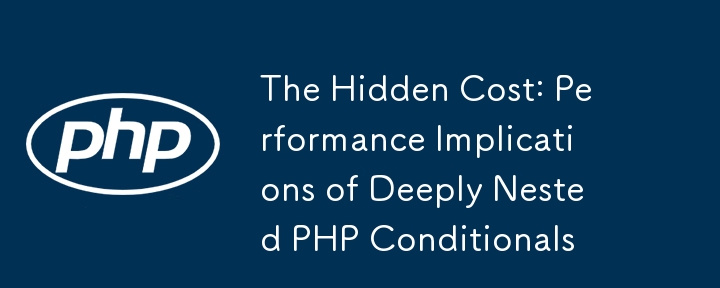 Backend Development
Backend Development
 PHP Tutorial
PHP Tutorial
 The Hidden Cost: Performance Implications of Deeply Nested PHP Conditionals
The Hidden Cost: Performance Implications of Deeply Nested PHP Conditionals
The Hidden Cost: Performance Implications of Deeply Nested PHP Conditionals
Jul 30, 2025 am 05:37 AMDeeply nested conditionals increase cognitive load and debugging time, making code harder to understand and maintain; refactoring with early returns and guard clauses simplifies flow. 2. Poor scalability arises as more conditions complicate CPU branch prediction, testing, and optimization, leading to combinatorial explosion; using configuration-driven rule systems improves extensibility and performance. 3. Testing and maintenance overhead grows with cyclomatic complexity, requiring more test cases and increasing the risk of untested edge cases; extracting logic into separate methods or classes enhances testability and reusability. 4. Although minor, deeply nested logic can lead to longer opcode sequences, slightly increasing compilation time and memory usage in OPcache, which may impact high-traffic applications over time. The real cost of nested conditionals lies not in raw execution speed but in reduced development efficiency, code reliability, and long-term scalability, which can be mitigated through flatter, more modular designs.

When PHP code relies on deeply nested conditionals—if, else if, else, and switch statements buried several layers deep—it might still work functionally, but it carries hidden performance and maintainability costs that many developers overlook. While the raw execution speed impact of nesting itself is minimal in modern PHP (especially with OPcache), the real performance implications are indirect but significant.

1. Increased Cognitive Load and Debugging Time
Deeply nested conditionals make code harder to read and reason about. Consider this example:
if ($user->isLoggedIn()) {
if ($user->hasRole('admin')) {
if ($request->isSecure()) {
if ($input->isValid()) {
// Do something
} else {
// Handle invalid input
}
} else {
// Handle insecure request
}
} else {
// Handle unauthorized role
}
} else {
// Handle unauthenticated user
}Each level adds a new mental context. Developers must track multiple conditions simultaneously to understand the flow. This increases the time required to debug or modify the logic—especially under pressure—effectively reducing team throughput.

Better approach: Early returns and guard clauses
if (!$user->isLoggedIn()) {
return $this->respondUnauthorized();
}
if (!$user->hasRole('admin')) {
return $this->respondForbidden();
}
if (!$request->isSecure()) {
return $this->respondInsecure();
}
if (!$input->isValid()) {
return $this->respondInvalid();
}
// Proceed with main logicThis flattens the structure, reduces indentation, and makes the control flow linear and predictable.

2. Performance Degradation via Poor Scalability
While a single conditional check is fast, deeply nested logic often signals poor design that doesn’t scale well:
- More conditions = more branching → harder for CPU branch prediction (minor but real at scale)
- Increased code paths → more complexity for testing and optimization
- Harder to cache or optimize — logic buried in conditionals is often state-dependent and not easily abstracted
For example, imagine rendering UI elements based on 4–5 nested user attributes. As the app grows, adding a new role or permission multiplies the number of required checks and test cases exponentially (combinatorial explosion).
Solution: Use configuration or rule-based systems
Instead of nesting, offload logic to data structures:
$accessRules = [
'admin' => ['secure', 'valid'],
'editor' => ['valid'],
];
$role = $user->getRole();
$required = $accessRules[$role] ?? [];
if (!in_array('valid', $required) || !$input->isValid()) {
// deny
}This is easier to extend, cache, and even store in a database or config file.
3. Testing and Maintenance Overhead
Every additional conditional branch increases the cyclomatic complexity of a function. High complexity means:
- More unit tests required for full coverage
- Higher chance of untested edge cases
- Slower refactoring due to fear of breaking logic
A function with 5 nested conditionals can have 10 execution paths. Testing all of them is time-consuming and often neglected in practice.
Practical fix: Extract conditions into methods or classes
private function authorizeUser($user, $request, $input): ?Response
{
return $this->checkAuthentication($user)
?? $this->checkRole($user)
?? $this->checkSecurity($request)
?? $this->validateInput($input);
}Now each check is isolated, testable, and reusable.
4. OPcache and Bytecode Implications (Minor but Real)
PHP compiles scripts into opcodes, and deeply nested logic can result in longer opcode sequences. While OPcache stores compiled scripts, excessively complex functions may:
- Take longer to compile initially (affects deployment or cold starts)
- Be less efficiently optimized by the Zend Engine
- Consume more memory in opcode cache
This is rarely a bottleneck, but in high-traffic applications with many such functions, it can add up.
Bottom line:
The performance cost of nested conditionals isn’t about microseconds—it’s about development speed, code reliability, and long-term scalability. Flattening logic with early returns, strategy patterns, or configuration-driven rules pays dividends in both maintainability and system performance over time.
Basically: your CPU handles nesting fine. Your team (and future self) won’t.
The above is the detailed content of The Hidden Cost: Performance Implications of Deeply Nested PHP Conditionals. For more information, please follow other related articles on the PHP Chinese website!

Hot AI Tools

Undress AI Tool
Undress images for free

Undresser.AI Undress
AI-powered app for creating realistic nude photos

AI Clothes Remover
Online AI tool for removing clothes from photos.

Clothoff.io
AI clothes remover

Video Face Swap
Swap faces in any video effortlessly with our completely free AI face swap tool!

Hot Article

Hot Tools

Notepad++7.3.1
Easy-to-use and free code editor

SublimeText3 Chinese version
Chinese version, very easy to use

Zend Studio 13.0.1
Powerful PHP integrated development environment

Dreamweaver CS6
Visual web development tools

SublimeText3 Mac version
God-level code editing software (SublimeText3)

Hot Topics
 From Arrow Code to Clean Code: Strategies for Simplifying Nested Ifs
Jul 30, 2025 am 05:40 AM
From Arrow Code to Clean Code: Strategies for Simplifying Nested Ifs
Jul 30, 2025 am 05:40 AM
To eliminate the complexity of nested if statements, you should use the guard clause to return in advance, merge conditional expressions, replace branches with polymorphic or policy patterns, and use lookup table mapping values; 1. Use the guard clause to process boundary conditions in advance and exit; 2. Use logical operations to meet and related conditions; 3. Use polymorphic or policy patterns to replace complex type branches; 4. Use dictionaries and other data structures to replace simple conditional mapping; ultimately make the code flat and linear, improving readability and maintainability.
 The Hidden Cost: Performance Implications of Deeply Nested PHP Conditionals
Jul 30, 2025 am 05:37 AM
The Hidden Cost: Performance Implications of Deeply Nested PHP Conditionals
Jul 30, 2025 am 05:37 AM
Deeplynestedconditionalsincreasecognitiveloadanddebuggingtime,makingcodehardertounderstandandmaintain;refactoringwithearlyreturnsandguardclausessimplifiesflow.2.PoorscalabilityarisesasmoreconditionscomplicateCPUbranchprediction,testing,andoptimizatio
 PHP Guard Clauses: The Superior Alternative to Nested If Statements
Jul 31, 2025 pm 12:45 PM
PHP Guard Clauses: The Superior Alternative to Nested If Statements
Jul 31, 2025 pm 12:45 PM
GuardclausesareasuperioralternativetonestedifstatementsinPHPbecausetheyreducecomplexitybyhandlingpreconditionsearly.1)Theyimprovereadabilitybyeliminatingdeepnestingandkeepingthemainlogicatthebaseindentationlevel.2)Eachguardclauseexplicitlychecksforin
 Architecting Control Flow: When to Use (and Avoid) Nested Ifs in PHP
Jul 31, 2025 pm 12:42 PM
Architecting Control Flow: When to Use (and Avoid) Nested Ifs in PHP
Jul 31, 2025 pm 12:42 PM
NestedifstatementsareacceptableinPHPwhentheyreflectlogicalhierarchies,suchasguardclauseswithclearearlyexits,hierarchicalbusinesslogic,orshallownesting(1–2levels),becausetheyenhanceclarityandmaintainflow.2.Deepnesting(3 levels),independentconditions,a
 Taming the Pyramid of Doom: Refactoring Nested If Statements in PHP
Aug 01, 2025 am 12:33 AM
Taming the Pyramid of Doom: Refactoring Nested If Statements in PHP
Aug 01, 2025 am 12:33 AM
To solve the "death pyramid" problem caused by nested if statements in PHP, the following five reconstruction methods should be adopted: 1. Use early return (guardclauses) to flatten the condition check to avoid deep nesting; 2. Extract complex conditions into a private method with clear names to improve readability and reusability; 3. Use verification objects or middleware mode for complex processes to achieve composable and extensible verification logic; 4. Use ternary or empty merge operators only in simple scenarios to avoid nested ternary expressions; 5. Use exceptions to replace error string return, handle errors in a centralized manner, and keep the core logic pure. The ultimate goal is to make the code safer, easier to test, and easier to maintain through rapid failure, logical separation and appropriate design patterns.
 Effective Error Handling and Validation with Nested If-Else Structures
Jul 31, 2025 am 11:59 AM
Effective Error Handling and Validation with Nested If-Else Structures
Jul 31, 2025 am 11:59 AM
Deeplynestedif-elseblocksreducecodereadabilityandmaintainability;2.Useearlyreturns(guardclauses)toflattenlogicandimproveclarity;3.Centralizevalidationwithresultobjectstoseparateconcernsandsimplifytesting;4.Applyvalidationpipelinesordecoratorsforreusa
 Mastering Complex Conditional Logic with PHP Nested Ifs
Jul 31, 2025 am 01:52 AM
Mastering Complex Conditional Logic with PHP Nested Ifs
Jul 31, 2025 am 01:52 AM
Nested if statements are not inherently bad in PHP. The key is to use them reasonably to maintain code readability and maintenance. 1. When the business logic is hierarchical (such as user permission check), nested if can clearly express dependencies, which is more intuitive than flattening conditions. 2. Avoid deep nesting over 2-3 layers, and simplify logic through early return (guardclauses) and highlight the main process. 3. When conditions are independent and have a considerable importance, the && or || merge conditions can be used, but if there is a pre-dependency (such as login status), nesting is more appropriate. 4. Complex judgments should be extracted into meaningful variables to improve readability and debugging convenience. 5. Pay attention to avoid excessive nesting, missing else branches, and in-conditions
 A Deep Dive into Nested Ternary Operators vs. Nested Ifs in PHP
Jul 31, 2025 am 04:59 AM
A Deep Dive into Nested Ternary Operators vs. Nested Ifs in PHP
Jul 31, 2025 am 04:59 AM
Nestedifstatementsarebetterthannestedternaryoperatorsforcomplexlogicbecausetheyaremorereadable,maintainable,andeasiertodebug;1.Useternaryoperatorsonlyforsimple,single-conditionassignments;2.Prefernullcoalescing(??)fordefaultvalues;3.Useifstatementsfo





